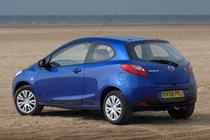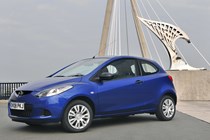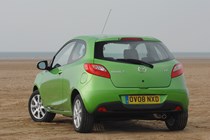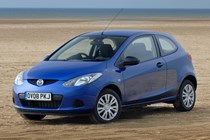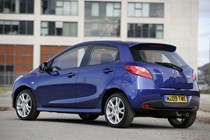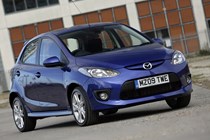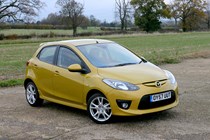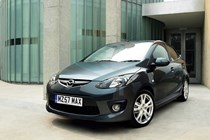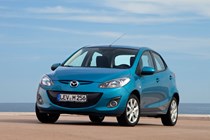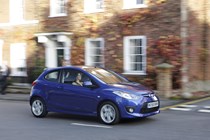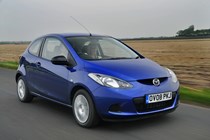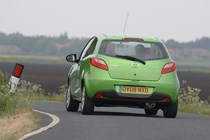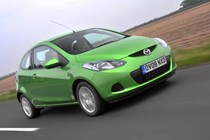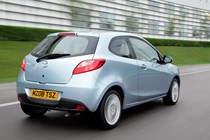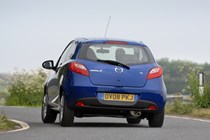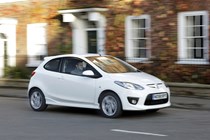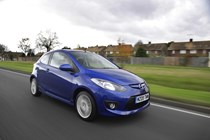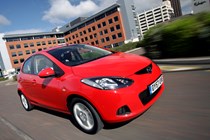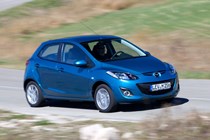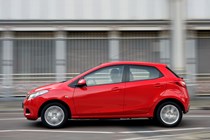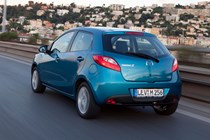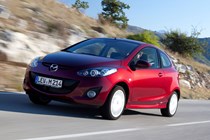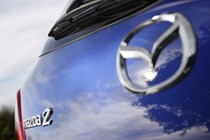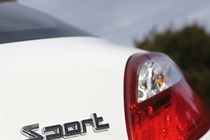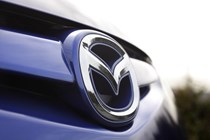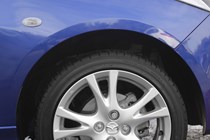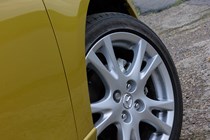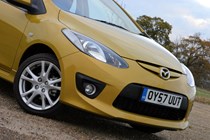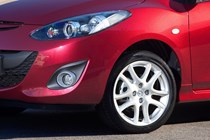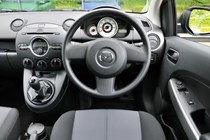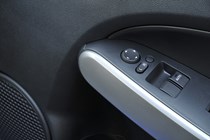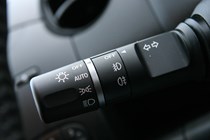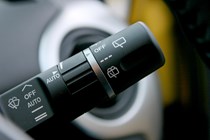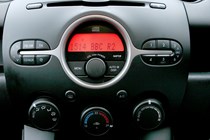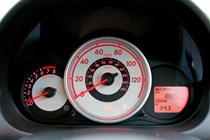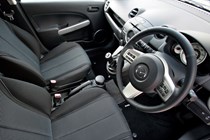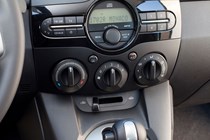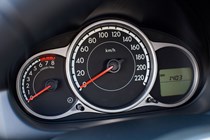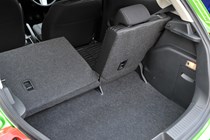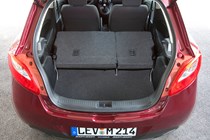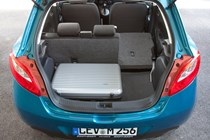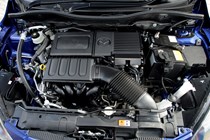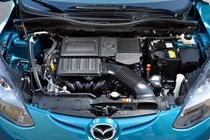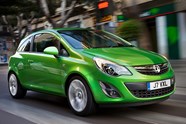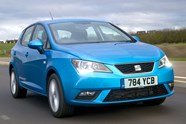
Mazda 2 Hatchback (2007-2015) review
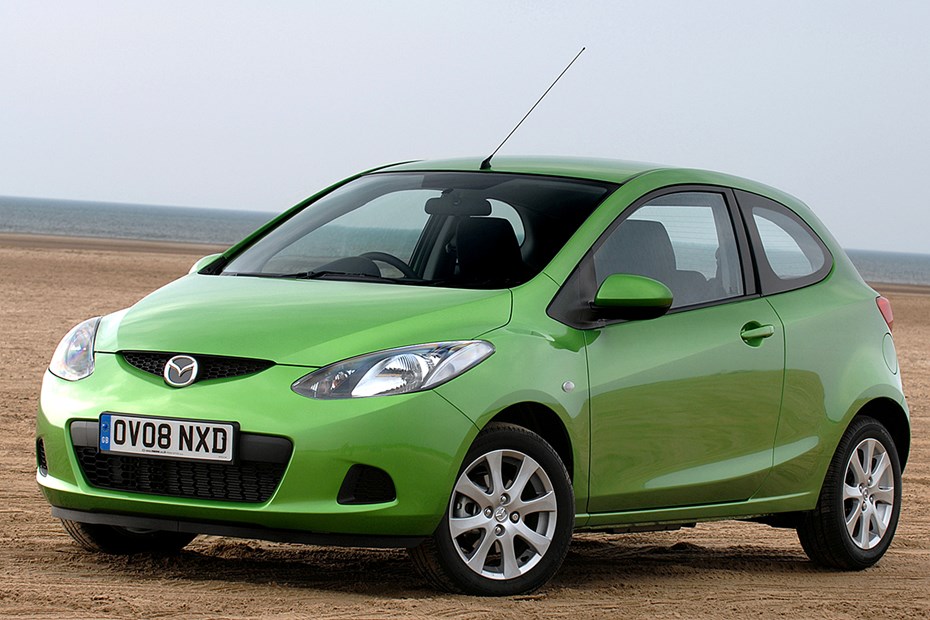
At a glance
| Price new | £7,810 - £14,795 |
|---|---|
| Used prices | £460 - £5,347 |
| Road tax cost | £20 - £215 |
| Insurance group | 9 - 16 |
Get an insurance quote with

|
|
| Fuel economy | Not tested to latest standards |
| Range | 407 - 628 miles |
| Number of doors | 3 - 5 |
| View full specs for a specific version | |
Available fuel types
Petrol
Diesel
Pros & cons
- Good to drive
- Stylish and sporty look
- Holds its value well
- Good equipment levels
- Awkward boot shape
- Noisy at speed
- Firm ride
Mazda 2 (07-15) rivals
Overview
The second-generation Mazda 2, sold in the UK from 2007 to 2015, was a smaller and lighter car than its predecessor, very much in tune the pared-back philosophy that also inspires the Mazda MX-5 roadster Based on the same platform as the contemporary Ford Fiesta, the Mk2 Mazda 2 is also good to drive. And shouldn’t be an expensive second-hand car to buy, run or fix.
Its main rivals in the highly competitive supermini segment at the time included that very Fiesta, the Vauxhall Corsa and the Toyota Yaris – all of which sold in greater numbers.
Mazda 2 Mk2 known faults and common problems
These days you can buy a used Mazda 2 Mk2 for well under £2,000 – and you know what? You’ll probably still be getting a pretty decent car. As long as you can see a good amount of service history, the petrol models have a great reliability record and the potential to keep going for yonks. The diesels are a little more troublesome, but they don’t make much sense in a city car anyway.
There are a few things to look out for, which we’ve highlight in the list below. But generally Mazda builds dependable vehicles, and the 2 is no exception.
Buying guide
Common issues, and what to look for if you’re looking at getting one
1) Clicking clutch pedal
Bit of a weird one, but there enough documented examples of this complaint to make it worth pointing out. Some blame a flimsy pedal box, others a simple spring, but if the clutch pedal clicks when you use it, you’re not likely to be looking at major bill if you ignore it.
2) Suspension wear
Beyond the usual burnt-out bulbs and worn wiper blades, one of the most common MOT failure points for the Mazda 2 is worn suspension. Check the tyres for uneven wear, and when taking a test drive listen for odd noises and wobbling and shuddering over bumps.
When new, this Mazda 2 was a fun little car to punt around – so if the example you’re considering isn’t that, walk away and find another.
3) Clunking power-steering
This is definitely one to aware of: if the steering clunks or feels anything other than perfectly smooth you are also best walking away. While it might be the steering column simply needs relubricating, it might also be a failure of the entire power-steering system. Which will be expensive to fix.
4) ABS failure
As with most cars, electronic sensor failures aren’t uncommon as the second-gen Mazda 2 gets older. Check carefully for warning lights and signs of issues in the service and MOT history. Failure of the anti-lock braking system (ABS) is a particular concern, as this may mean an expensive ABS module replacement.
5) Boot release failure
Another relatively common electronic issue with the Mk2 Mazda 2 is failure of the boot release. It’s easy to make sure this works when you’re viewing a car – just don’t forget to actually check it. A good point for negotiation, perhaps.
6) Air-conditioning issues
It’s not unusual for older cars to have poor air-conditioning – sometimes they’re just in need of a re-gas. But if the air-con hasn’t been used regularly you could be looking at a bigger bill, as the seals and compressors rely on action to remain lubricated and effective.
The Mazda 2 can also suffer with a noisy air-flow controller – listen for repeating clicking noises, especially when switching between blower modes.
7) Lightweight build quality
Mazda likes to make its cars as lightweight as possible, which is great for fuel economy, not so good for refinement. This generation of Mazda 2 is noisy inside and generally feels a little flimsy, so don’t surprised by rattling trim on high-mileage examples. We’d forgive this if the car is cheap enough.
A bigger issue is likely to be thin paint and a general lack of corrosion protection – the former resulting in stone chips, the latter likely to allow creeping rust over time. Check the MOT history carefully…
8) Dubious diesel engines
While we like the Mazda 2 Mk2 in general, we wouldn’t be quick to recommend one of the diesel versions. Both the 1.4D – which is really a Peugeot-Citroen engine – and the more powerful 1.6D can suffer with injector issues. They’re noisy, too.
9) Petrol engines with uneven idle
Whether you pick a 1.3-litre or 1.5-litre petrol engine, these should prove much more robust. But you still want to look for plenty of service history, as missed oil changes will increase engine wear.
The petrols can become carbonised over time as well, especially on higher mileage cars that have been run on cheaper fuel (which is likely given this is a cheap car to begin with). A telltale sign of this in uneven idle, so listen for rising and falling revs when stationary during the test drive.
10) Second / city car hardships
As a relatively inexpensive small car, this generation of Mazda 2 is likely to have spent a lot of time doing short journeys in urban environments. So look out for signs of hastily disguised kerbed wheels and scraped bumpers – although be realistic about the condition you’re likely to get based on the advertised price.
What models and trims can you buy?
The standard Mazda 2 trim levels for this generation were TS, TS2 and Sport – though Mazda is a massive fan of special editions, so you’ll find plenty of additional models such as the Tamura, Takuya and Venture Edition as well.
Standard equipment was ok for the time, but not overwhelmingly generous. Especially in terms of safety, as not every model even got electronic stability control.
The 1.3-litre petrol engine came in a couple of power outputs, making the basic 75hp version quite slow while the punchier 87bhp variant is more than adequate for such a small car. The bigger 1.5-litre petrol gives you just over 100hp, but doesn’t really seem worth the increased fuel consumption.
The Peugeot-Citroen sourced 1.4-litre turbodiesel offers 68hp, the bigger – and better – Mazda 1.6-litre diesel turbodiesel 90hp. Both are economical if in good shape and used for longer journeys, but likely to be more of a liability if used for short trips around town.
There was a minor facelift for the second-generation Mazda 2 in 2010, desirable for the better-quality interior trim.
Over the next few pages, we’ll review each aspect of the Mazda 2, taking into account its practicality, comfort, fuel economy and performance. If you’re short on time, you can also skip to our verdict page to see if we recommend the Mazda 2 Mk2 as a good used car.



